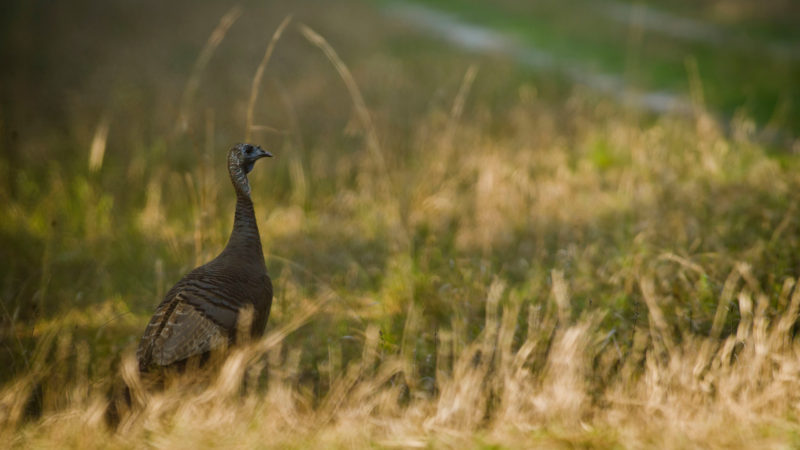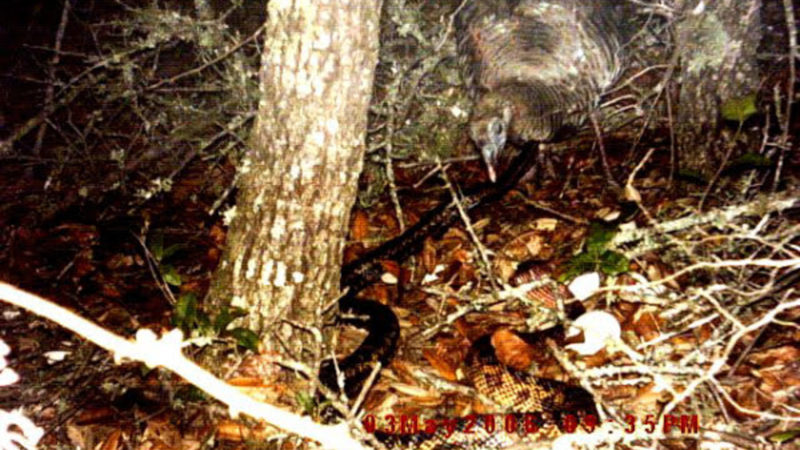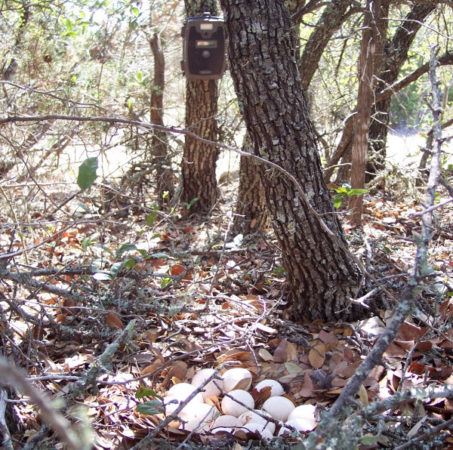by Bret Collier via HuntingWire
Sticking with our theme of talking about turkeys (at least for now), I thought I might detail some thoughts on wild turkey reproduction, nest success, and nest predation. As all turkey hunters know, annual recruitment this year defines the male population status two years into the future. So, most of the science and management was done on and for turkeys is focused on increasing recruitment or the number of poults hitting the ground each summer.
From a research perspective here in the southeast, we are right at the start of the reproductive season, and the graduate students are just now starting to see nests hitting the ground en masse in the last week. For us and the female turkeys we are monitoring, what we want to see is nest success, which from a scientific perspective is the percentage of nests that are successful, that is, hatch at least one egg.
Nest success is generally used as a proxy for the general productivity of populations each year, and because nests are easy to monitor and we can collect lots of data about the nest site, like measurements of vegetation type and community structure, prescribed fire or timber management regime, and how far the nest is/was from various anthropogenic things like houses and roads. We combine all these data to try and use information from successful and unsuccessful nests to direct land management activities.

Most conservation efforts to reduce nest loss in wild turkeys have focused on habitat creation and maintenance, as the amount of usable vegetation that wild turkeys can select to nest in has long been thought to reduce the chance of nest loss. But, what causes a nest to be successful remains a complicated and elusive question that I spend quite a bit of time thinking about.
Nesting is an interesting time for a female wild turkey. Females usually travel quite a long way when starting a nest, up to a few miles in one direction, and often, the nest sites are outside of the female’s home range. Thus, most females have never seen the location where they end up putting their nest until the day they walk up to it and lay their first egg.
During the 12-14 days that a female spends laying eggs, they move around quite a bit (1–2 miles a day) but only use a small area (<500 acres), and we think that they are doing two things—evaluating what resources are available around their nest site, and trying to stay away from the nest site as much as possible, so they don’t draw attention to where she is laying eggs.
When incubation starts, the amount of area a female uses declines to about 30 acres she uses during incubation recesses, and she stays there for the 26-28 days of incubation. Thus, that 30 acres around the nest site becomes the most important space in the world for that female, as what is in, or not in, that 30 acres can dictate whether the nest is successful. Generally speaking, about 20 to 25% of nests are successful during any given year, but it can be as low as 5% and as high as 50% on specific study sites.

Many factors cause nests to fail, but we can generally group failures into two categories: the nest/nesting female is predated, or the female is somehow disturbed and abandons the nests’ site. Of course, these are not mutually exclusive—for instance, a failed predation attempt on a female where she survives may cause her to abandon her nest site and start anew.
Nest predation is well known to be the primary source of nest loss for nearly all avian species, and there is no doubt that nest predation is the primary cause of nest loss for wild turkeys, where it often accounts for 90% or more of the nests we lose each season. As nest predation impacts populations, research and managers continue to focus on what can be done to mitigate nest predation across the landscapes.
One of the most regular questions I get from landowners and managers and the ever-present social media feeds is this: What eats turkeys nests/causes turkey nests to fail? The answer is everything, but also not what you think. When a nesting attempt fails, there are two things that could have happened, either 1) the predator is after the hen, not the nest, so nest loss is a function of hen mortality, and then some scavenger comes across and eats the eggs that are at the nest site, or 2) the hen is driven off or survives the attempted predation on her, and when she gets back, her nest has been scavenged (predated) so she has to go set up shop somewhere else.
Generally speaking, both instances occur, and the species responsible for the various predation events can be different. If the female is driven off the nest due to disturbance or a predation event, then pretty much everything in nature will eat the eggs in a nest. What few photographs of wild turkey nests that have been predated on tend to show is that when eggs are left unprotected on the landscape, everything eats them…but does that make everything a nest predator?
I tend to look at it like this: if a species attempts to predate the hen, and does, then the nest is by default going to fail, so any critter that comes to eat an egg is a scavenger. As few species, outside of snakes, are more interested in the eggs than the hen, most of the critters that we have historically called nest predators are probably more accurately classified as empty nest scavengers, such as raccoons, skunks, opossums, feral hogs, etc.
And finally, I get to the real question you all were waiting on, what can we as managers and hunters do to reduce wild turkey nest predation. The answer is elusive in that it is not as simple as remove predators, increase nest success. We have all heard stories about folks who started trapping, and turkey populations skyrocketed.

Trapping is a great recreational sport and certainly enjoyable, but unfortunately, I don’t see it as a range-wide panacea for increasing the nest success of wild turkeys. Removing all potential nest predators at a manageable scale is usually not an option, as the community is diverse and consists of a variety of species that are well outside of the typical furbearers like raccoons, bobcats, and coyotes that are typically targeted during recreational fur harvest operations.
So, where does that leave us? I think it comes down to creating ample vegetative communities so that females have lots of options for where she can put her nest, not because the vegetation she chose hid her from predators per se, but that the predator species just happened to avoid using the particular vegetation type that she put her nest in. Thus, by creating and maintaining usable space in our continually fragmented landscapes, we may be creating areas that nest predators just avoid going into, which has the added benefit of creating more turkeys for all of us to enjoy.

 By
By 



